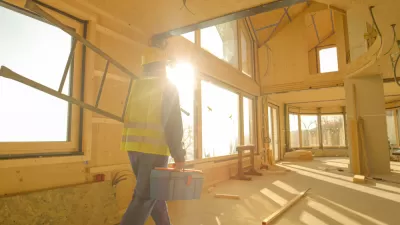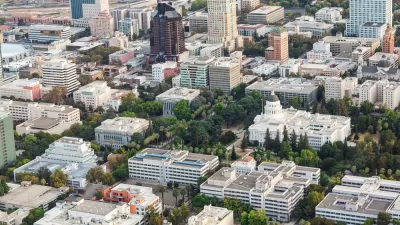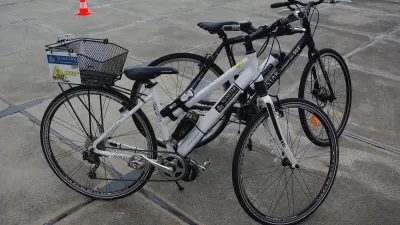Every component of a building, from the concrete foundation to the paint on the walls, has an impact on human health, the climate, and ecosystems around the globe. Building materials—once overlooked in real estate’s sustainability efforts—are now bei

Every component of a building, from the concrete foundation to the paint on the walls, has an impact on human health, the climate, and ecosystems around the globe. Building materials—once overlooked in real estate’s sustainability efforts—are now being recognized as key to achieving net zero carbon emission targets and delivering healthy places for tenants and communities.
For First United Bank, a regional bank headquartered in Durant, Oklahoma, choosing the right construction materials for its new branch locations became an important way for the company to outwardly express its people- and planet-focused values.
“First United wanted the buildings to integrate and showcase sustainable strategies while inspiring and relating to their customer base,” according to project architect, Taylor Coleman, a senior associate at Gensler. “Using mass timber proved to be an excellent way to achieve these goals.”
The inviting, light-filled lobby of First United Bank’s branch in Fredericksburg, Texas, is characterized by wood—lots of it. Completed in 2019, the 8,500-square-foot (790 sq m) building was the first fully mass timber structure in the state and the first project in the country to use cross-laminated timber (CLT) panels made from southern yellow pine, a locally grown and sourced wood.
Compared with traditional materials like concrete and steel, mass timber has a much lower environmental impact and has been shown to improve occupant health and well-being by evoking nature—a concept known as biophilia.
After completing the Fredericksburg branch, First United Bank and Gensler partnered on two additional mass timber bank buildings in Shawnee, Oklahoma, and Sherman, Texas. Gensler is now designing more than 2 million square feet (185,800 sq m) of mass timber buildings for Walmart’s new home office campus project in Bentonville, Arkansas, and working on Under Armour’s Baltimore global headquarters, another fully mass timber project.
These projects are representative of a larger industry trend favoring sustainable construction materials.
Over the last decade, this movement has mainly been championed by architecture and design firms, but real change will be possible only with coordinated efforts across the industry, says Diane Hoskins, Gensler’s co-CEO. “The decarbonization of the built environment is a complex challenge requiring the entire real estate sector to move toward low-carbon solutions.”
Spurred by increasingly restrictive regulations, reporting requirements, and growing demands from investors and tenants, the industry’s sustainability efforts are now taking materials into account.
An upcoming ULI report, The Material Movement: Creating Value with Better Building Materials, outlines the driving forces behind this shift and highlights key steps that developers and asset managers can take to mitigate their environmental impact and enhance health through building materials
FULL STORY: The Materials Movement: Advancing Low-Carbon, Healthy Materials for Sustainable Communities (ULI)

Planetizen Federal Action Tracker
A weekly monitor of how Trump’s orders and actions are impacting planners and planning in America.

Congressman Proposes Bill to Rename DC Metro “Trump Train”
The Make Autorail Great Again Act would withhold federal funding to the system until the Washington Metropolitan Area Transit Authority (WMATA), rebrands as the Washington Metropolitan Authority for Greater Access (WMAGA).

The Simple Legislative Tool Transforming Vacant Downtowns
In California, Michigan and Georgia, an easy win is bringing dollars — and delight — back to city centers.

The States Losing Rural Delivery Rooms at an Alarming Pace
In some states, as few as 9% of rural hospitals still deliver babies. As a result, rising pre-term births, no adequate pre-term care and "harrowing" close calls are a growing reality.

The Small South Asian Republic Going all in on EVs
Thanks to one simple policy change less than five years ago, 65% of new cars in this Himalayan country are now electric.

DC Backpedals on Bike Lane Protection, Swaps Barriers for Paint
Citing aesthetic concerns, the city is removing the concrete barriers and flexposts that once separated Arizona Avenue cyclists from motor vehicles.
Urban Design for Planners 1: Software Tools
This six-course series explores essential urban design concepts using open source software and equips planners with the tools they need to participate fully in the urban design process.
Planning for Universal Design
Learn the tools for implementing Universal Design in planning regulations.
Smith Gee Studio
City of Charlotte
City of Camden Redevelopment Agency
City of Astoria
Transportation Research & Education Center (TREC) at Portland State University
US High Speed Rail Association
City of Camden Redevelopment Agency
Municipality of Princeton (NJ)





























